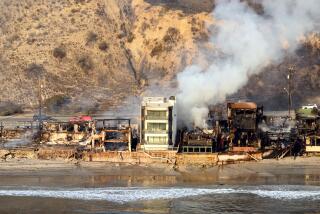Building Code in Panhandle Less Strict
- Share via
TALLAHASSEE — When Florida adopted a statewide building code in answer to Hurricane Andrew, it set tough storm construction standards well inland for much of the state -- but not the Panhandle.
At the time, homebuilders and legislators argued that the extreme northwestern edge of the state wasn’t prone to the assault of high winds and the code could unreasonably increase the cost of homes.
Hurricane Ivan, with its 130 mph winds, may have changed some minds.
Within hours of Ivan’s devastating rampage through Pensacola early Wednesday, two area legislators said the Legislature should revisit the standards that were set for the Panhandle.
“An event like this proves why we need the strictest standards,” said Rep. Dave Murzin (R-Pensacola). “When you talk to people and hear that the ceiling fell in, you understand why you have building codes. Yeah, it might add a little to the price of the home you live in, but it’s better than losing everything in one storm.”
Sen. Durrell Peaden (R-Crestview) agreed.
“It’s something that is going to have to be looked at by the Legislature, especially with the damage to the hospitals and the Red Cross shelter,” he said. “Maybe we should not delineate areas for special exemptions.”
The Florida Building Code was adopted by the Legislature in 2000 and took effect in 2002. It was partly the result of eight years of work prompted by the ruin left by Hurricane Andrew as it hit Miami-Dade County in 1992 with sustained winds of 140 mph and gusts up to 164.
The code sets minimum standards for construction and requires that new homes in areas prone to hurricane-strength winds be equipped with special shutters, have impact-resistant glass or be designed to withstand sustained winds of 120 to 130 mph. In South Florida, the standards are 130 to 150 mph.
“We’ve already been documenting the effectiveness of the new code, based on what we’ve seen with Hurricanes Charley and Frances,” said Sam Miller of the Florida Insurance Council. “It’s very clear.... The new construction is less damaged.”
But in North Florida, from Jefferson County west to the Alabama line, the code’s requirements extend only one mile from the Gulf.
The exemption was pushed by Panhandle Sen. Charles Clary (R-Destin), an architect who argued that the area had not experienced winds as destructive as Andrew’s.
It was agreed to by homebuilders and Florida’s then-secretary of Community Affairs, Steven Seibert, who said he and Gov. Jeb Bush favored reduced requirements.
Sen. Lee Constantine (R-Altamonte Springs), who was in the state House when he helped write the code, hopes the Florida Building Commission will come up with new recommendations.
“I know the code has worked well,” Constantine said. “And I don’t believe I’ll have to fight off others who keep trying to lower the standards, at least for the next few years.”
Richard Dixon, executive director of the Florida Building Commission, said his group plans to review the damage.
“We plan to look at what are the lessons learned,” he said. “We have to see how the buildings built to the new standards fared.”
Mike Hickman, president of the Florida Homebuilders Assn., said his members thought the new code was doing what it was supposed to although no one yet knew the full impact that Hurricane Ivan had a mile away from the coastline.
But he agreed the Legislature needed to look at the storm’s effects and what type of housing fared the best.
“We need to look at what is safe and what are we permitting to build that isn’t,” Hickman said.
On Thursday afternoon, George Touart, the chief administrator of Escambia County, got his first glimpse of the damage wrought on his hometown.
The historic district was in shambles. Homes were waterlogged. In one 200-home subdivision next to the Intracoastal Waterway, more than a third of the homes were gone, leaving only pilings or concrete slabs behind.
“It was just unbelievable devastation,” he said, adding other subdivisions fared just as poorly. “I’m not sure any building code could withstand the damage we saw.”
More to Read
Sign up for Essential California
The most important California stories and recommendations in your inbox every morning.
You may occasionally receive promotional content from the Los Angeles Times.













